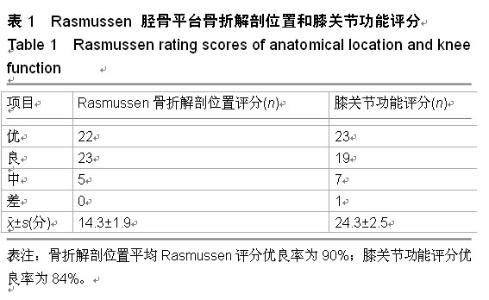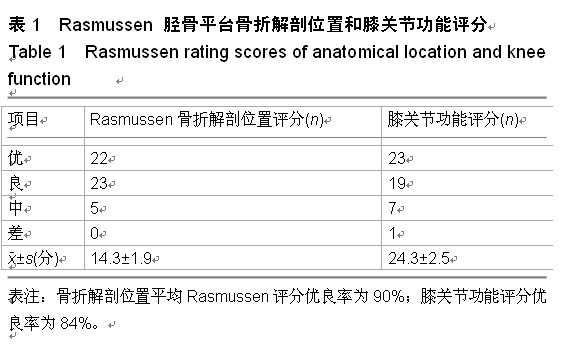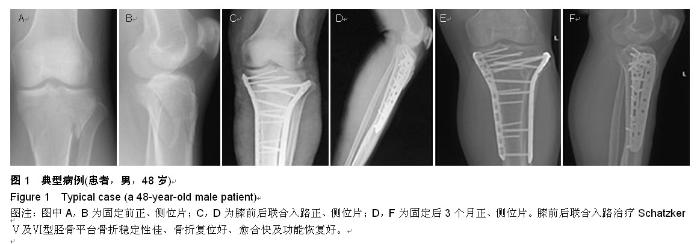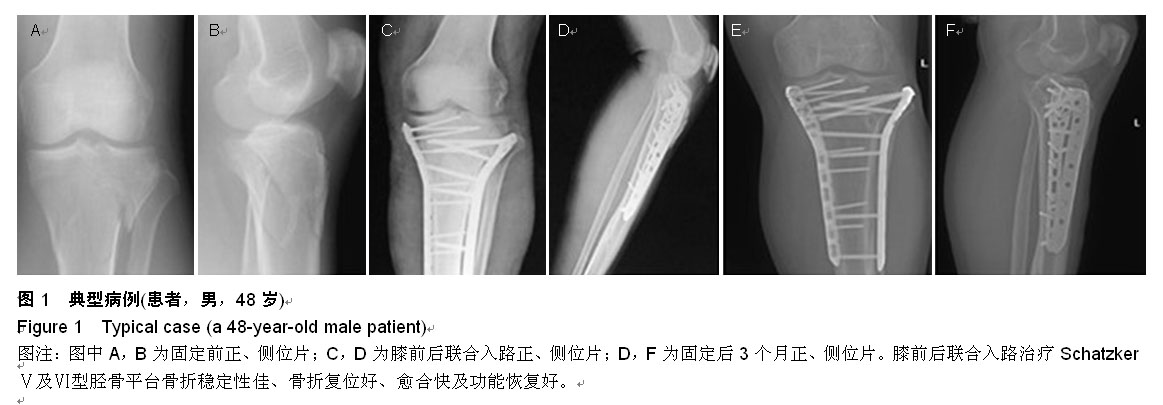| [1] 林真富,罗伟,谢怀春,等.复杂胫骨平台骨折固定治疗分析[J].华西医学,2011,26(10):1511-1513.
[2] 周建华,张功林,赵来绪.后内侧入路治疗Schatzker Ⅴ及Ⅵ 型胫骨平台骨折[J].国际骨科学杂志,2014,35(4):272-273, 276.
[3] 苏振刚,史源欣,邵伟忠.双切口双钢板固定治疗Schatzker Ⅴ及Ⅵ 型胫骨平台骨折[J].实用骨科杂志,2011,17(7):603-605.
[4] 汪志芳,李丹勇,郭健行,等.关节镜辅助下空心钉微创内固定治疗SchatzkerⅠ-Ⅳ型胫骨平台骨折26例疗效分析[J].中国骨与关节损伤杂志,2014,29(8):831-832.
[5] 王永宏,戴守达,董小雄,等.双钢板支撑治疗 Schatzker Ⅴ及Ⅵ型胫骨平台骨折[J].中国骨与关节损伤杂志,2011,26(2): 157-158.
[6] 严广斌.膝关节评分标准[J].中华关节外科杂志(电子版),2010, 4(6):845.
[7] Pun TB, Krishnamoorthy VP, Poonnoose PM, et al. Outcome of Schatzker typeⅤand Ⅵ tibial plateau fractures. Indian J Orthop. 2014;48(1):35-41.
[8] Prasad GT, Kumar TS, Kumar RK, et al. Functional outcome of Schatzker typeⅤand Ⅵ tibial plateau fractures treated with dual plates. Indian J Orthop. 2013;47(2):188-194.
[9] 刘喜俊.膝关节镜下辅助经皮内固定和切开复位内固定治疗胫骨平台骨折疗效对比观察[J].临床医学,2014,34(11):93-94.
[10] 张峻玮,孙磊,毕宏政,等.胫骨平台骨折的固定治疗进展[J].中国矫形外科杂志,2014,22(14):1280-1283.
[11] 胡勇,尹宗生,张辉,等.累及后柱的胫骨平台骨折的固定治疗[J].中华骨科杂志,2012,32(12):1138-1144.
[12] 陈文龙,张英琪,张世民. SchatzkerⅣ型胫骨平台骨折及固定入路研究[J].国际骨科学杂志,2014,35(2):97-99.
[13] 夏江,俞光荣,周家钤,等.经后外侧入路治疗胫骨平台后外侧骨折的解剖学研究及应用[J].中国临床解剖学杂志,2010,28(4): 369-374.
[14] 陈宏兴.内外侧切口双解剖型钢板加植骨治疗SchatzkerⅤ及Ⅵ 型胫骨平台骨折的临床研究[D].济南:山东中医药大学,2012.
[15] 王国军,杨照田,孙杰.单侧支撑钢板结合空心加压螺钉治疗 Schatzker Ⅴ型胫骨平台骨折[J].中外医疗,2010,29(14):46.
[16] 徐云钦,李强,申屠刚,等.复杂胫骨平台骨折固定时机与固定方式选择及疗效分析[J]. 中国骨与关节损伤杂志,2013,28(4): 320-323.
[17] Babis GC, Evangelopoulos DS, Kontovazenitis P, et al. High energy tibial plateau fractures treated with hybrid external fixation. J Orthop Surg Res. 2011;14(6):35.
[18] Taylor J, Langenbach A, Marcellin-Little DJ. Risk factors for fibular fracture after TPLO. Vet Surg. 2011;40:687-693.
[19] Ariffin HM, Mahdi NM, Rhani SA, et al. Modified hybrid fixator for high-energy Schatzker Ⅴ and Ⅵ tibial plateau fractures. Strategies Trauma Limb Reconstr. 2011;6(1): 21-26.
[20] 徐云钦,李强,申屠刚,等.三种固定方法在复杂胫骨平台骨折中的应用[J].中华创伤骨科杂志,2010,12:281-283.
[21] 胡超,蔡林,王建平,等.累及后髁复杂性胫骨平台骨折的固定治疗[J].中国骨与关节损伤杂志,2012,27(8):749-750.
[22] Biggi F, Di Fabio S, D'Antimo C, et al. Tibial plateau fractures: internal fixation with locking plates and the MIPO technique. Injury. 2010;41:1178-1182.
[23] 徐云钦,李强,申屠刚,等.膝前正中直切口双侧钢板内固定治疗复杂性胫骨平台骨折[J].中国骨与关节损伤杂志,2010,25(4): 346-347.
[24] 罗雪峰.前后联合入路治疗胫骨平台后柱骨折疗分析[D].乌鲁木齐:新疆医科大学,2013.
[25] Hashemi J, Chandrashekar N, Mansouri H, et al. Shallow medial tibial plateau and steep medial and lateral tibial slopes: new risk factors for anterior cruciate ligament injuries. Am J Sports Med. 2010;38(1):54-62.
[26] Brunner A, Horisberger M, Ulmar B, et al. Classification systems for tibial plateau fractures: does computed tomography scanning improve their reliability? Injury. 2010; 41(2):173-178.
[27] Markhardt BK, Gross JM, Monu JU, et al. Schatzker classification of tibial plateau fractures: use of CT and MR imaging improves assessment. Radiographics. 2009;29(2): 585-597.
[28] 刘卫峰,郭峰,汪建良,等.门形钉治疗后交叉韧带胫骨止点撕脱性骨折[J].中国骨与关节损伤杂志,2012,27(1):80-81.
[29] 沙磊,臧银善,耿庆贺,等.Carlson 后内侧入路钢丝抽出缝合固定治疗膝后交叉韧带胫骨止点撕脱骨折[J].中国骨与关节损伤杂志,2012,27(2):158-159.
[30] 蒋昊靖,何向东,金勤富.缝线锚钉内固定治疗后交叉韧带胫骨止点撕脱骨折[J].中国骨与关节损伤杂志,2013,28(12):1184-1185.
中国组织工程研究杂志出版内容重点:人工关节;骨植入物;脊柱;骨折;内固定;数字化骨科;组织工程
|



